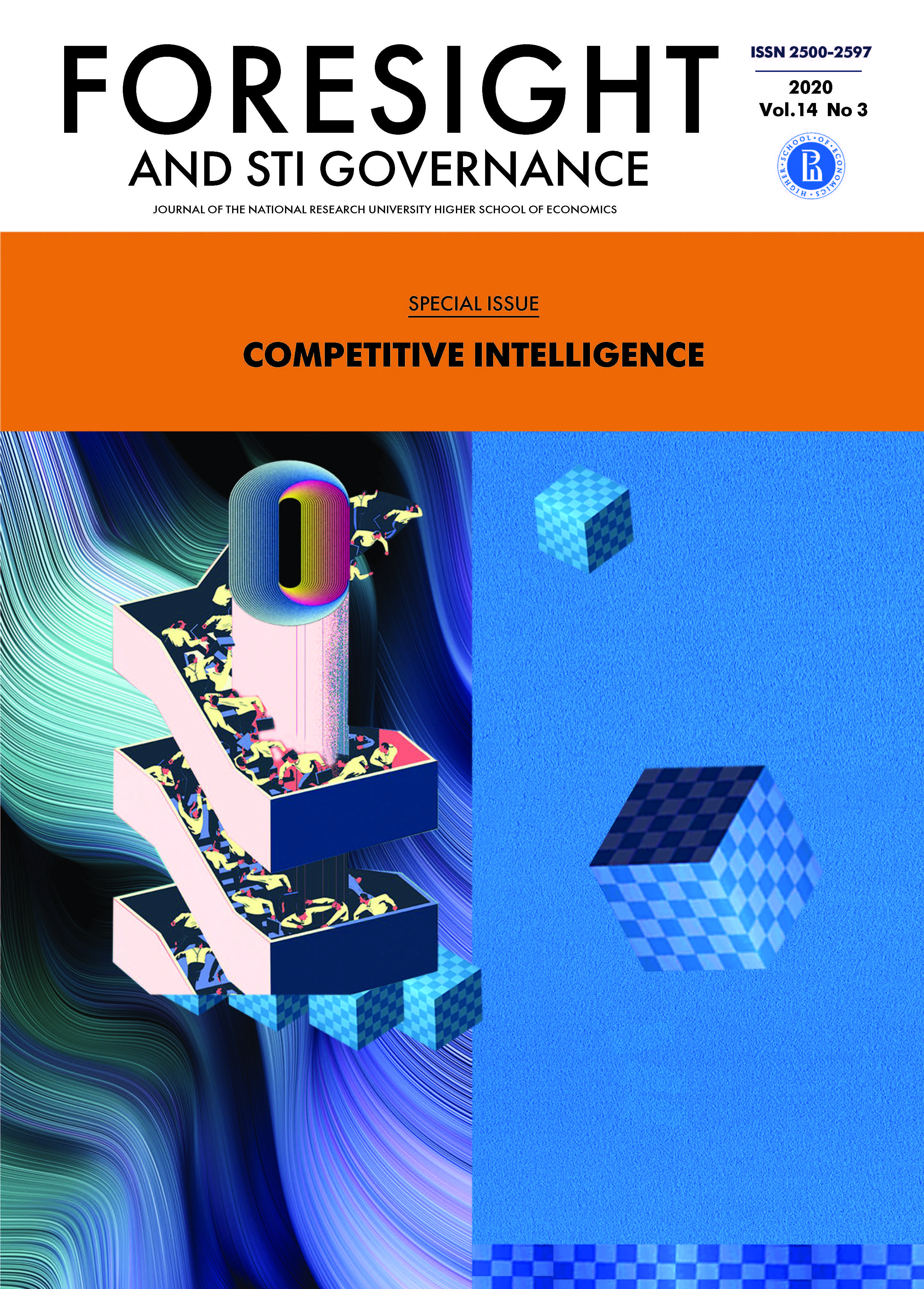Abstract
This paper focuses on the practices, assessment approaches, procedures, and applied aspects of competitive intelligence (CI). The study relies upon a survey of CI practitioners conducted in 2019 and a comparison of its results with a similar survey in 2006. It was found that companies spend the time devoted to this activity mainly on processes that go beyond collecting information, including planning, analysis, communications, and management. Most enterprises have official divisions and profile managers. The results are used to perform a variety of strategic and tactical tasks.
The main sources of information are the Internet, company employees, customers, and industry experts. Compared to 2006, a new key resource has emerged — social networks. Of the analytical methods, SWOT analysis and the study of competitors are most often used. Several channels of communication are used simultaneously to disseminate the received information, mainly email and presentations are used. Key performance criteria are customer satisfaction and the number of decisions made based on the information gathered.
A comparative analysis revealed that over the period separating the surveys of 2006 and 2019, the function of the CR has become more formalized. The share of companies with centralized divisions and CI managers has grown. Currently, this activity more often goes beyond the simple profiling and evaluation of competitors. Technology assessment, economic, and political analysis are more actively practiced.
References
Badr A., Madden E., Wright S. (2006) The contribution of CI to the strategic decision-making process: Empirical study of the European pharmaceutical industry // Journal of Competitive Intelligence and Management. Vol. 3. № 4. P. 15-35.
Barnea A. (2016) Study on Competitive Intelligence in Israel // Journal of Intelligence Studies in Business. Vol. 6. № 2. P. 5-16.
Bisson C., Tang Tong M.M. (2018) Investigating the competitive intelligence practices of Peruvian fresh grapes exporters // Journal of Intelligence Studies in Business. Vol. 8. № 2. P. 43-61.
Brody R. (2008) Issues in defining competitive intelligence: An exploration // Journal of Competitive Intelligence and Management. Vol. 4. № 3. P. 3-16.
Bulger N.J. (2016) The Evolving Role of Intelligence: Migrating from Traditional Competitive Intelligence to Integrated Intelligence // The International Journal of Intelligence, Security, and Public Affairs. Vol. 18. № 1. P. 57-84. DOI: https://doi.org/10.1080/23800992.2016.1150691
Calof J. (2017a) Canadian competitive intelligence practices - a study of practicing strategic and competitive intelligence professionals' Canadian members // Foresight. Vol. 19. № 6. P. 577-589. Режим доступа: , дата обращения 26.05.2020. DOI: https://doi.org/10.1108/FS-07-2017-0024
Calof J. (2017b) Reflections on the Canadian Government in competitive intelligence - programs and impacts // Foresight. Vol. 19. № 1. P. 31-47. Режим доступа: , дата обращения 26.05.2020. DOI: https://doi.org/10.1108/FS-08-2016-0038
Calof J., Skinner B. (1998) Competitive intelligence for managers // Optimum. Vol. 28. № 2. P. 38-43.
Calof J.L. (2016) Government sponsored competitive intelligence for regional and sectoral economic development: Canadian experiences // Journal of Intelligence Studies in Business. Vol. 6. № 1. P. 48-58.
Calof J.L., Arcos R., Sewdass N. (2018) Competitive intelligence practices of European firms // Technology Analysis and Strategic Management. Vol. 30. № 6. P. 658-671. DOI: https://doi.org/10.1080/09537325.2017.1337890
Crayon (2019) State of Competitive Intelligence 2019. Режим доступа: https://www.crayon.co/state-of-competitive-intelligence, дата обращения 02.05.2019.
Crayon (2020) State of Competitive Intelligence 2020. Режим доступа: https://www.crayon.co/state-of-competitive-intelligence, дата обращения 02.02.2020.
Dishman P.L., Calof J.L. (2008) Competitive intelligence: A multiphasic precedent to marketing strategy // European Journal of Marketing. Vol. 42. № 7/8. P. 766-785.
Du Toit A. (2015) Competitive intelligence research: An investigation of trends in the literature // Journal of Intelligence Studies in Business. Vol. 5. № 2. P. 14-21.
Du Toit A.S.A., Sewdass N. (2014) Competitive intelligence in Morocco // African Journal of Library, Archives and Information Science. Vol. 24. № 1. P. 3-13.
Fehringer D., Hohhof B., Johnson T. (eds.) (2006) State of the Art Competitive Intelligence. Competitive Intelligence Foundation Research Report. Alexandria, VA: Society of Competitive Intelligence Professionals.
Fleisher C.S., Bensoussan B.E. (2007) Business and Competitive Analysis. Upper Saddle River, NJ: FT Press.
M-Brain (2015) Global Market Intelligence Survey 2015. Режим доступа: https://www.m-brain.com/blog-posts/2015-market-intelligence-survey-report/, дата обращения 12.02.2020.
M-Brain (2019) Global Market Intelligence Survey 2019. Режим доступа: https://www.m-brain.com/white-papers/global-intelligence-survey-2019/ дата обращения 17.03.2020.
McGonagle J.J. (2016) Guide to the study of intelligence // Journal of U.S. Intelligence Studies. Vol. 22. № 2. P. 55-59.
Nasri W. (2011) Competitive Intelligence in Tunisian Companies // Journal of Enterprise Information Management. Vol. 24. № 1. P. 53-67.
Ojinaga E.R.P. (2018) Exploratory study of competitive intelligence in Mexico // Journal of Intelligence Studies in Business. Vol. 8. № 3. P. 22-31.
Sewdass N., Du Toit A.S.A. (2014) Current state of competitive intelligence in South Africa // International Journal of Information Management. Vol. 34. № 2. P. 185-190.
Sewdass N., Du Toit A.S.A. (2015) Competitive Intelligence in emerging economies: A comparative study between Brazil and South Africa // TD The Journal of Transdisciplinary Research in Southern Africa. Vol. 11. № 1. P. 113-132.
Sharp S. (2000) Truth or Consequences: 10 Myths that Cripple Competitive Intelligence // Competitive Intelligence Magazine. Vol. 3. № 1. P. 1-6.
Stanat R. (2008) Global competitive intelligence blueprint // Competitive Intelligence Magazine. Vol. 11. № 3. P. 6-11.
Tanev S., Bailetti T. (2008) Competitive intelligence information and innovation in small Canadian firms // European Journal of Marketing. Vol. 42. № 7/8. P. 786-803. Режим доступа: , дата обращения 16.04.2020. DOI: https://doi.org/10.1108/03090560810877150

This work is licensed under a Creative Commons Attribution 4.0 International License.

